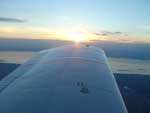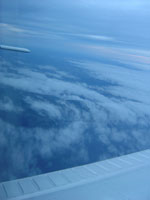

75
DAYS TO GO
![]()
DONATE
| HOME |
| DIARY |
| ROUTE |
| SPONSORS |
| PRESS ROOM |
| BREMEN FLIGHT |
| CHARITY |
| THE AIRCRAFT |
| THE PILOTS |
| CONTACT US |
© Copyright World Flight 2002-2003
| July 10th, Saint
Johns to Shannon, direct After arrival at Goose Bay July 7th we studied the weather forecast for the next few days. The forecast was bad. Our plan was always to fly from Goose Bay to Iceland which is the shortest sea crossing and therefore the more sensible route. After Iceland we would fly to Wick in Scotland and then home to Shannon. The problem with this proposed route were the low pressure systems moving north east to Iceland from the Atlantic. Front after front moved in from the Atlantic towards Iceland. A blocking high over Ireland and the UK which was squeezing the low systems north east towards Iceland rather than the Lows usually sweeping over Ireland. July 8th was the big decision day. We arrived at Goose Bay airport, bags packed and ready to attempt the Iceland leg. From the weather we would be racing a large low pressure system which was south west of Iceland and due to pass over Iceland bringing stormy conditions later that day. If we decided to go that day we would be faced with 35 knot headwinds from Greenland to Iceland, not pleasant news. The flight would take 13 hours and landing in very poor weather conditions at Iceland. We were unhappy to go and fly direct into the low system especially as conditions were deteriorating at Keflavik Airport in Iceland. The decision was made not to go and sit it out. The only clearing we could see would be to wait until Friday but then once we arrived in Iceland we would be stuck again for some days waiting for weather to improve to fly to Scotland. Nether of us wanted this and were keen to get home as we were so close. The 70 day trip was catching up on us and we were both tired and fatigued so getting home soon was important. Hours were spent pouring over Synoptic weather charts and it looked like a possible weather window was opening up to fly direct from Canada to Shannon on Wednesday. There would not be comfort of Greenland as a diversion airfield or Iceland onroute if we few direct though. Any problems encountered mid Atlantic would put is in a very bad situation for survival being a very long way from anywhere. Weather is all interpretation, it is certainly not a guaranteed science so you have to analysis the situation form the charts and make your own conclusion as to what you think will happen 12 hours, 24 hours in the future. We decided to go with the direct plan but to do this we would have retrace our steps and fly 3 1/2 hours south again to Saint John's in Newfoundland which is the nearest point in Canada for Shannon. We left late in the evening for Saint John's and flew into the night to where the weather was much worse than at Goose Bay. Mist obscured the airport with a ceiling of 400 feet. We were not sure if we could get in to Saint John's with these conditions and Gander would be our diversion airport if needed. Paul flew the ILS carefully and at decision height we popped out from the mist and the runway appeared directly in front of us. This was one of our more spectacular approaches with Saint John's Airport suddenly appearing through the mist. Saint John's was a beautiful city, we had expected for some reason for it to be a very small town but it is a large city with a lovely deep water port. Next day we were at the airport with new weather charts to study. Paul put the routing together and Alan worked on the weather. This was a division of tasks which we naturally fell into and suited us both. We had two concerns with the weather. First it was terrible weather at Saint John's, gusting 30 knots in driving heavy rain showers with a ceiling of 400 feet. This poor weather was caused by a low pressure systems approaching from the west. A cold front was passing through Saint John's at that time. This low pressure system was heading east into the Atlantic and developing, our plan was to leave before the center of the low arrived and fly ahead of it across the Atlantic. Mid Atlantic we had clearer weather with a high pressure system having a stabilizing effect. At the same time a cold front was moving towards the west coast of Ireland. What we planned to do was to take off at the right time to just get ahead of the Centre of the low approaching Saint John's, accept the bad weather associated with this system and head east. We would be flying into good weather with 30-40 knot tailwinds from the low speeding our progress. Timing our departure from Saint John's just at the right time would result in us arriving in Shannon after the cold front had passed through leaving good flying conditions for our approach. That was the plan, the reality can be very deferent when you get flying. A departure time was set for 7pm local time July 9th. To prepare for this long flight over the treacherous Atlantic we got suited up. Under our flight suits we wore a thermal suit called a "Bunny Suit" which would keep us warm in event of a ditching. Over this we wore our flight suits and then put on our orange Emerson suits which like a dry suit would keep us dry in the water for up to 7 hours. Finally over all our layers we had our life jackets, emergency beacon, personal flares and firefly strobe beacon. After suiting up it was difficult to move and uncomfortable. Climbing into the aircraft with difficulty we moved our seats as far forward as possible to help the centre of gravity of the aircraft. We had for the second time on the World Flight trip filled our ferry tank to max capacity putting 150 Gallons of fuel behind us or 900lbs of weight. Our main fuel tanks were also full at 84 Gallons giving us 234 Gallons of fuel - 15 hours duration at 6,000 feet. The aircraft was once again very heavy and with winds gusting 25 knots, a wet runway and ceiling of now 800 feet the departure was anything but ordinary. Using up most of the runway we climbed away into the cloud on climb to 6,000 feet with turbulent conditions for the first 3,000 feet. Settling into the cruise we were direct to Shannon. Leaving the Canadian coast we switched to HF (long range) radio and spoke with Gander Control. Our signal was very week and Gander was having difficulty in hearing us. Our position report was passed to Gander by a British Airways "Speedbird" airliner somewhere above us at 38,000 feet. They were interested to hear what we were doing flying at 6,000 feet over the Atlantic and asked "had we our wet suits onboard...". Our aerial which served us very well around the world is a trailing wire antenna which we reel out from the right seat. We suspected the aerial may be damaged which would cause our transmitter to be only putting out 25 watts instead of the normal 100 watts. So we pulled in the aerial, brought out the tools and wired up our spare antenna. Essential to the flight has been able to do some inflight repairs, especially with HF as so much can go wrong. Reeling out the new aerial we were back loud and clear with Gander Control. Passing position reports to Air Traffic Control is very important as there is no radar coverage over the Atlantic so the only way Air Traffic Control know where aircraft are is by position reports. In the event an aircraft did not call in at a expected position Air Traffic Control would know the aircraft's last position and also where it was due to be so a search and rescue area could be established. It is a very big ocean so keeping in touch with Air Traffic Control is essential. Flying through the night dawn broke with the bright sky in the north visible. Mid Atlantic we made contact with Shanwick Control who are based at Shannon and control the air traffic east side of the Atlantic. We were greeted by a friendly Irish voice on the radio congratulating us our circumnavigation of the globe. It was good to hear the Irish accent and meant we were nearing home. We climbed to avoid cloud to 9,000 feet. Below we could make out the Atlantic Ocean, the sea was very rough with large swells and filled with "white horse" waves. It would certainly not be easy to ditch the aircraft successfully in such high seas - looking down from 9,000 feet it was best not to ponder such an event but to keep busy and press on towards home. We had after 210 hours flying the Cherokee Six great confidence in it's engine and after the Pacific crossing we both felt much more comfortable crossing the Atlantic. Approaching the coast of Ireland we were welcomed over the VHF radio by Station Manger of Shannon Airport Air Traffic Control. He congratulated us on our"epic journey", it was a great feeling to hear this over the airwaves as we looked down on the rugged Irish coastline. Our approach to Shannon was made easier as this was the first airfield on our world trip where we had already been there before. On landing, Aer Rianta sent a guard of honour fire truck to escort us to the parking area where a welcoming reception committee awaited us with the media. Stretching our legs we shook hands and realised we had completed the world trip which at one time not so long ago seemed a far away dream. We were both delighted to be home and to meet our families but sad to see the end of this trip of a life time. Only in a few days when we have time to think back will we fully realise the full extent of our achievement. Thanks to everyone who supported us and made World Flight 2003 a true success. |
|


